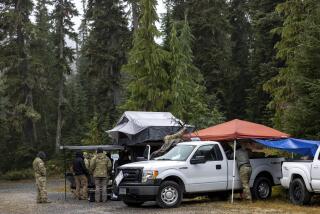These Pilots Remember Quiet Times of WWII
- Share via
“It was an ugly aircraft, but it was very effective,” said San Diegan Carl Gwartney, describing the glider he flew on dangerous missions during World War II. “We could drop troops off in hard-to-reach places.”
Gwartney is one of 80 people from throughout Southern California who will convene at the Bahia Hotel this weekend to meet old friends, reminisce and talk about their flying missions at a mini-reunion of World War II glider pilots.
“The purpose of the reunion is to talk and exchange war stories,” said Gwartney, who moved to San Diego in 1950 to work as a printer at the San Diego Union until he retired in 1982. “There will be a videotape in the hospitality room where people can see what it was like.”
The glider pilots played a major role in World War II owing to their ability to quietly drop first-strike paratroopers into remote areas without being detected.
Carried 16 Men
Although the box-shaped CG-4A planes may have looked ugly, they had the capacity to carry 4,000 pounds, which translated to 16 men, fully equipped. They had an 83-foot wingspan and were 47 feet long. They also landed troops and badly needed equipment in key strategic points behind enemy lines.
“They used the glider because they were quiet. They could land in such a short area--similar to today’s helicopter,” Gwartney said. “With the glider, we could put a squad of men ready to fight anywhere.”
“The planes would be towed to their destination by a C-46 plane and then cut off to glide,” Gwartney said. “They would then glide, sometimes up to six hours, to reach the target. During the missions, each plane would have a pilot and co-pilot. Sometimes they didn’t use a co-pilot because of the shortage” of pilots.
After dropping off their cargo of paratroopers, the glider pilots would try to head back to a base, or look for a place to land and abandon the plane. They then would try to walk or hitch a ride back to a base, fighting alongside other troops.
Gwartney said he was being trained to fly a glider though the contraptions had not yet been designed.
“To be a glider pilot you had to go through special training,” Gwartney said. “In the early days, you had to have 300 hours of flight time. We flew light planes and turned the engine off. In January of 1943, the first plane was built. We tried it for two months and were sent to a tactical outfit, where we trained with the famed 82nd Airborne division.”
Gwartney said that, in addition to flying the glider planes, the pilots were used on all aircraft during the war.
“We were used as co-pilots on the C-47 and C-46 engine planes,” Gwartney said. “We were also used as navigators in other planes.”
First Use Disastrous
The first use of the gliders in Africa proved to be a disaster, he said, as the planes flown by both British and American pilots crashed into the ocean or were shot down.
“Twenty-five pilots and planes were used during the first mission. They did a lousy job of flying the planes. The whole thing was bad. Some of the planes dropped into the ocean and some of our own Navy shot some of the aircraft down.”
Despite their ill-fated inaugural mission, 13,909 CG-4A planes would be built and used throughout Europe in Normandy, southern France, Holland and Bastogne. The plane was designed by Waco Aircraft of Troy, Ohio, and built by the Ford Motor Co., Cessna and other manufacturers, Gwartney said.
If it hadn’t been for the atomic bombs dropped on Hiroshima and Nagasaki, “they would have used the glider to go into Japan,” Gwartney said.
The World War II Glider Pilots Assn. held its first reunion in 1965. At that time, the organization had 5,000 members. Today there are 1,400 members.
More to Read
Sign up for Essential California
The most important California stories and recommendations in your inbox every morning.
You may occasionally receive promotional content from the Los Angeles Times.










